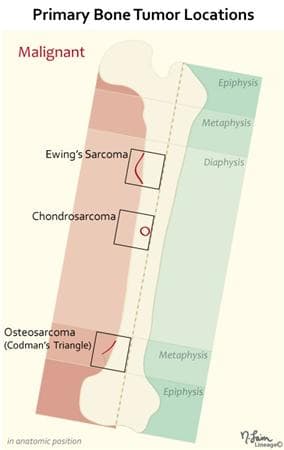Overview

Ewing Sarcoma
- Introduction
- boys < 15 has highest incidence
- most often seen in diaphysis of long bones, pelvis, scapula, and ribs
- Evaluation
- Prognosis, Prevention, and Complications
- early metastasis
- responsive to chemotherapy
Chondrosarcoma
- Introduction
- malignant cartilaginous tumor
- seen in men 30-60 years
- most commonly involves the central skeleton
- may occur de novo or from progression of osteochondroma
- Evaluation
- expansile glistening mass
- located in the medullary cavity
Osteosarcoma (osteogenic sarcoma)
- Introduction
- tumor of osteoblasts
- most common primary malignant tumor of bone
- commonly found in the metaphysis of long bones
- e.g. distal femur or proximal tibia
- Evaluation
- Prognosis, Prevention, and Complications
- poor prognosis
Bone Metastasis
- Introduction
- typically result in osteolytic lesions
- exception is prostatic carcinoma
- produces osteoblastic lesion



